Bipolar Coagulation
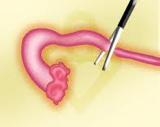 The most popular method of laparoscopic female sterilization, this method uses electrical current to cauterize sections of the fallopian tube. Depending on the number of sites coagulated, tube damage is typically only 2 or 3 centimeters in length and pregnancy rates after reversing this procedure are about 70%.
The most popular method of laparoscopic female sterilization, this method uses electrical current to cauterize sections of the fallopian tube. Depending on the number of sites coagulated, tube damage is typically only 2 or 3 centimeters in length and pregnancy rates after reversing this procedure are about 70%.
Fimbriectomy

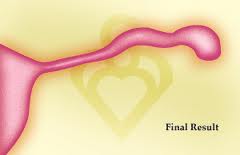
By removing a portion of the fallopian tube closest to the ovary, fimbriectomy eliminates the ovary’s ability to capture eggs and transfer them to the ovary. Reversing this procedure involves opening the remaining fallopian tube and folding out the inner tubal lining so that egg capture is again possible. This procedure has the lowest success rates and repair is therefore not recommended. In vitro fertilization is usually the preferred treatment in these cases.
Irving Procedure
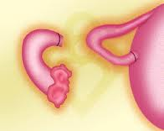 This procedure calls for placing two ligatures (sutures) around the fallopian tube and removing the segment of tubing between the ligatures. Then to complete the procedure, the ends of the fallopian tubes are connected to the back of the uterus and the connective tissue respectively. Fortunately, this procedure usually leaves two healthy fallopian tube sections and a pregnancy rate of around 70% on average.
This procedure calls for placing two ligatures (sutures) around the fallopian tube and removing the segment of tubing between the ligatures. Then to complete the procedure, the ends of the fallopian tubes are connected to the back of the uterus and the connective tissue respectively. Fortunately, this procedure usually leaves two healthy fallopian tube sections and a pregnancy rate of around 70% on average.
Monopolar Coagulation
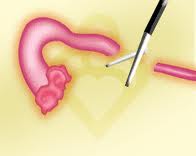 Less common than Bipolar Coagulation, Monopolar Coagulation uses electrical current to cauterize the tube together, but also allows radiating current to further damage the tubes as it spreads from the coagulation site. Many cases involve a cutting of the tubes after the procedure. Due to the fallopian tube damage from this procedure, pregnancy rates drop to approximately 45%. However if tubal length is still greater than 5 centimeters, then a 70% pregnancy success rate can be achieved.
Less common than Bipolar Coagulation, Monopolar Coagulation uses electrical current to cauterize the tube together, but also allows radiating current to further damage the tubes as it spreads from the coagulation site. Many cases involve a cutting of the tubes after the procedure. Due to the fallopian tube damage from this procedure, pregnancy rates drop to approximately 45%. However if tubal length is still greater than 5 centimeters, then a 70% pregnancy success rate can be achieved.
Tubal Clip
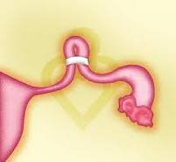 The tubal clip or Hulka Clip technique involves the application of a permanent clip onto the fallopian tube. Once applied and fastened, the clip disallows transference of eggs to the ovary. Reversal and pregnancy success is best with this procedure and can be as high as 85%.
The tubal clip or Hulka Clip technique involves the application of a permanent clip onto the fallopian tube. Once applied and fastened, the clip disallows transference of eggs to the ovary. Reversal and pregnancy success is best with this procedure and can be as high as 85%.
Tubal Ring
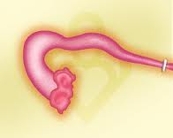 The silastic band or tubal ring method involves a doubling over of the fallopian tubes and application of a silastic band to the tube. Pregnancy success rates can also be very high with this method if only a small portion of the tube is damaged by the rings.
The silastic band or tubal ring method involves a doubling over of the fallopian tubes and application of a silastic band to the tube. Pregnancy success rates can also be very high with this method if only a small portion of the tube is damaged by the rings.
Pomeroy Tubal Ligation
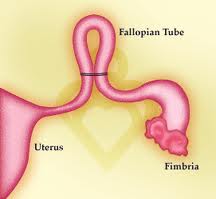 In this method of tubal ligation, a loop of tube is “strangled” with a suture. Usually, the loop is cut and the ends cauterized or “burned“. This type of tubal ligation is often referred to as cut, tied, and burned. These are usually very good for reversal. The fact that the ends are burned doesn’t matter because that part is going to be lost anyway during the tubal reversal.
In this method of tubal ligation, a loop of tube is “strangled” with a suture. Usually, the loop is cut and the ends cauterized or “burned“. This type of tubal ligation is often referred to as cut, tied, and burned. These are usually very good for reversal. The fact that the ends are burned doesn’t matter because that part is going to be lost anyway during the tubal reversal.
Essure
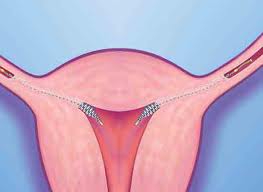 In this method of tubal ligation, two small metal and fiber coils are placed in the fallopian tubes. After insertion, scar tissue forms around the coils, blocking off the fallopian tubes and preventing sperm from reaching the egg.
In this method of tubal ligation, two small metal and fiber coils are placed in the fallopian tubes. After insertion, scar tissue forms around the coils, blocking off the fallopian tubes and preventing sperm from reaching the egg.
Adiana
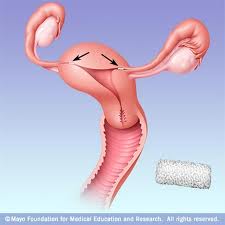 In this method of tubal ligation, two small silicone pieces that are placed in the fallopian tubes. During the procedure, your health care provider heats a small portion of each fallopian tube and then inserts a tiny piece of silicone into each tube. After the procedure, scar tissue forms around the silicone inserts, blocking off the fallopian tubes and preventing sperm from reaching the egg.
In this method of tubal ligation, two small silicone pieces that are placed in the fallopian tubes. During the procedure, your health care provider heats a small portion of each fallopian tube and then inserts a tiny piece of silicone into each tube. After the procedure, scar tissue forms around the silicone inserts, blocking off the fallopian tubes and preventing sperm from reaching the egg.
Important: You must provide your current height and weight in order for our surgeons to determine if they can perform a tubal reversal procedure on you in our surgery center. Falsifying information on these forms may result in the cancellation of your surgery and forfeiture of fees. Please answer these questions on the forms section of our website.
Check your BMI here to see how your weight affects the cost of your tubal reversal surgery.
Patients who undergo tubal reversal surgery at NCCRM must be accompanied by an adult over the age of 18 on the day of surgery and should expect to be driven home or to a hotel to recover by her companion.
Click here to visit our video page and watch videos about Tubal Reversal Surgery at NCCRM.
Click here to see the success rates of tubal reversal surgery at NCCRM.
For more information, please call 919-233-1680 ext. 180 or